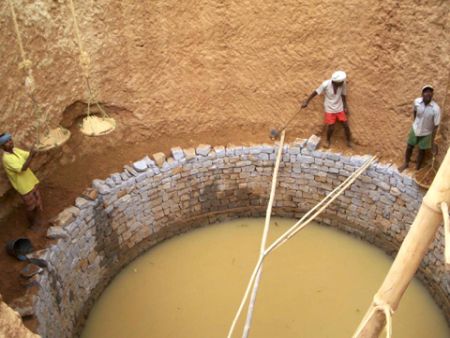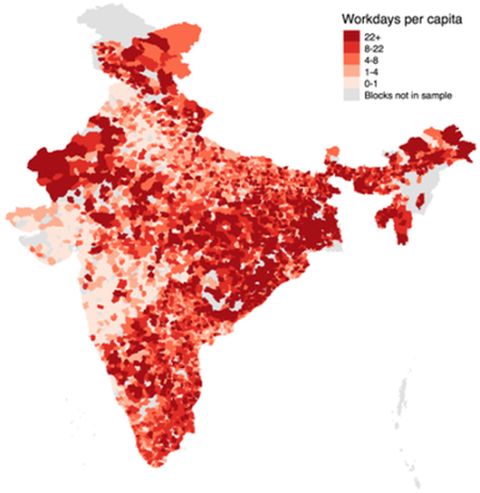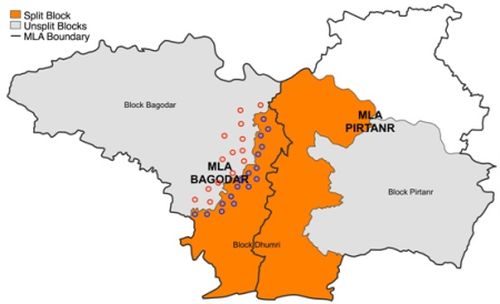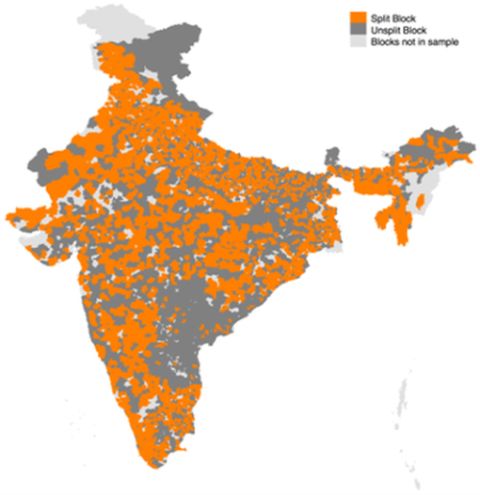
Political interference in the bureaucracy is generally viewed with suspicion. However, in India bureaucrats implement MNREGA much better in places where politicians are able to claim credit for improvements.
Many scholars, journalists, and other critical observers view political interference into the bureaucratic apparatus of the State with suspicion. And with good reason: politicians often use their influence to give out government jobs as patronage (Callen et al. 2016) and engage in corrupt acts with bureaucrats (Wade 1982). Such political actions are usually detrimental for citizen welfare and democracy more generally.
Consider the Mahatma Gandhi National Rural Employment Guarantee Act (MNREGA), one of the world's largest employment programmes, with an annual cost of about US$6 billion. The programme guarantees 100 days of minimum wage employment every year, to each rural household in India. Beneficiaries typically carry out physically strenuous work such as building wells, digging ditches, levelling land, and constructing roads (see Figure 1 below for an example). Despite its promise, the implementation of MNREGA is dramatically irregular. In Figure 2, we present block-level MNREGA data from 2013, and show how the programme implementation varies tremendously from one rural development block to the next.
Figure 1 MNREGA worksite in Jharkhand

Source: Authors.
Figure 2 Local variation in MNREGA Implementation

Source: Official MNREGA data, 2013.
MNREGA does work well in some places at the micro level. This raises the question of what drives such successful programme implementation. One possible explanation relates to the incentives facing politicians and how those politicians shape development outcomes. Indeed, a central promise of democratic accountability is that citizens elect politicians in order to hold bureaucrats accountable. We examine whether and to what extent greater political influence may improve bureaucrats' motivation to improve the implementation of development programmes like MNREGA.
Leveraging the uneven overlap of politician and bureaucrat jurisdictions
Studying the impact of political interference in the bureaucracy is hard. First, we cannot directly observe how all politicians interact with all local bureaucrats. Second, we cannot observe the effort of all bureaucrats (for instance, whether they go to the trouble of creating new worksites, signing up individuals who wish to work, or processing paperwork in order to get labourers in the programme paid). For these reasons measuring the direct impact of political influence on the bureaucracy is not straightforward. We focus instead on the product of bureaucratic effort: the implementation of MNREGA, and how that implementation varies as politicians' incentives change.
Still, a further potential problem with simply comparing political influence and bureaucratic effort is that external factors could cause both a decrease in bureaucratic performance and worse political oversight. For instance, bureaucratic performance may be worse in rural areas far from where politicians live, which itself would result in weaker political oversight.
To overcome such concerns, we use the political geography of boundaries in India – specifically that political and bureaucratic jurisdictions across India overlap unevenly. In India, jurisdictions of Members of the State Legislative Assemblies (MLA) often unevenly split the jurisdictions of block-level MNREGA bureaucrats, who are critical cogs in the delivery of development services at the local level.1 For example, in Figure 3 below, we show that block Dhumri (in orange), in the state of Jharkhand, is split across two MLA constituencies (marked by thick lines): Bagodar to the west and Dhumri to the east. By contrast, the blocks in grey (Bagodar to the west and Pirtanr to the east) are fully contained within a single MLA politician's constituency. As we show in Figure 4, many blocks are similarly split across multiple MLA constituencies throughout India.
Figure 3 An illustration of split blocks from Jharkhand

Source: Authors; Geographic Information System (GIS) and Indian Census data from New York University (NYU) Library.
Note: Circles depicting gram-panchayats are for illustrative purposes only.
Figure 4 Uneven overlap of jurisdictions across India

Source: Authors; GIS and Indian Census data from NYU Library.
Why should this overlap affect the incentives politicians face? We posit that politicians are less likely to exert effort monitoring bureaucrats whose jurisdictions overlap with other politicians ('split' bureaucrats), as compared to bureaucrats whose jurisdictions are wholly contained within a single politicians' jurisdiction ('unsplit' bureaucrats). Why? We argue that politicians more easily claim credit for the successful implementation of development programmes where the local bureaucrat falls completely within their jurisdiction. By contrast where the bureaucrat is split across multiple political constituencies, credit for monitoring bureaucrats has to be shared between politicians. The second situation creates weaker incentives for politicians to monitor bureaucrats.
Villagers enjoy better employment opportunities when bureaucrats report to a single politician
To test this hypothesis, we compare MNREGA performance both in split bureaucratic areas and in unsplit bureaucratic areas. We create an original dataset from official MNREGAS data sources, for all of India, at the village cluster (or gram panchayat) level. We combine this dataset with geographic coordinates, administrative and political boundaries, as well as village-level information from the 2001 Census.
To test our theory more sharply, we examine just those village clusters that lie very close to the boundary of a split and unsplit bureaucrat within the same politician's constituency, as illustrated with red and blue circles in Figure 3. Comparing villages in a very narrow geographic window around the boundary helps rule out many competing explanations of why two blocks may be different from one another besides the nature of the politician-bureaucrat interaction. We expect villages close to either side of the boundary to have similar levels of economic development, geographic conditions, historical legacies, and so on. The only plausible difference between them should be whether their bureaucrat reports to a single politician or to more than one. As a result, the difference in MNREGA implementation we observe is attributable to the unevenly overlapping jurisdictions that result in some bureaucrats reporting to more than one politician.
We find splitting bureaucrats' jurisdictions across politician boundaries worsens development. More specifically, MNREGA workdays in village clusters within split bureaucrats' jurisdictions (the blue circles in Figure 3) are about 9% lower than the corresponding number in unsplit bureaucratic village clusters (the red circles). We observe a similar difference if we look at the total number of people who worked on MNREGA projects in 2013. Figure 5 presents these results graphically. We plot the difference between split and unsplit blocks while varying the distance of village clusters to the block boundary. The points represent the average difference between split and unsplit blocks in percentages, while the grey area represents the degree of statistical uncertainty.
Figure 5 Difference in MNREGA outcomes between split and unsplit blocks


The differences we observe are sizeable. They amount to an annual penalty of about US$3,000 in wages for village clusters in split versus unsplit jurisdictions. In addition, the difference worsens every time a bureaucrat reports to an additional politician - a roughly 5% decrease in employment for each additional politician.
MNREGA implementation improves when politicians benefit electorally
We found that when political influence is divided, MNREGA implementation is worse. This suggests that politicians exercise their influence where it is easiest for them to do so. Naturally, when politicians have to push multiple bureaucrats to deliver development services, those things are less likely to get done. But under what conditions should we expect politicians to care most about getting bureaucrats to work?
Three additional tests help increase confidence that it is indeed electoral incentives that drive MNREGA outcomes. First, we show that when bureaucrats report to multiple politicians from different parties (compared to a situation where they report to multiple politicians from the same party), MNREGA employment outcomes worsen. This may be because voters have a harder time assigning blame when politicians overseeing a bureaucrat belong to different parties. Second, as the political importance of a block increases, the difference between MNREGA performance in split and unsplit bureaucratic areas attenuates.2 This shows that when politicians face significant electoral pressure, politicians will push bureaucrats to do their job whether the block is split or not. Finally, the difference in MNREGA implementation between split and unsplit blocks is lower in Indian National Congress (INC) constituencies as compared to non-INC constituencies. We believe this is because INC politicians are better able to claim credit for the implementation of MNREGA because of the INC's leadership role in passing the Act.3
Implications for development programmes
Politicians have an important role to play in the operation of development schemes. They realise that large development programmes offer an important opportunity to earn favour with voters. For this reason, large-scale development programmes are often named after important political figures. NREGA for instance, was re-named after Mahatma Gandhi, one of INC's most important founding ideological leaders. Similarly, the Benazir Income Support Programme in Pakistan, a conditional cash transfer programme, was started by the Pakistan Peoples' Party and named after its late leader and former Prime Minister of Pakistan, Benazir Bhutto.4
Our results show that political influence over the bureaucracy can dramatically improve the implementation of critical development programmes when politicians are presented with the right electoral incentives. Politicians will effectively push bureaucrats to improve development services when they are able to claim credit for those improvements. Our findings suggest that incorporating politician incentives into the design of development programmes will improve the effectiveness of basic government service delivery in India and beyond.
Editor’s Note: This column was first published on Ideas for India.
References
Gulzar, Saad and Benjamin Pasquale (2017), "Politicians, Bureaucrats, and Development: Evidence from India", American Political Science Review.
Aiyar, Y and S Samji (2009), 'Transparency and accountability in NREGA: a case study of Andhra Pradesh', Accountability Initiative Working Paper No. 1, New Delhi.
Berry, Christopher (2008), "Piling On: Multilevel Government and the Fiscal Common-Pool", American Journal of Political Science 52(4): 802-820.
Callen, M, S Gulzar, A Hasanain and Y Khan (2016), 'The Political Economy of Public Sector Absence: Experimental Evidence from Pakistan', NBER Working Paper No. 22340.
Dutta, P, R Murgai, M Ravallion and D van de Walle (2014), Right to Work?: Assessing India´s Employment Guarantee Scheme in Bihar, World Bank Publications, Washington DC.
Callen, M, S Gulzar and A Rezaee, (2020), 'Can Political Alignment be Costly?', Journal of Politics.
Wade, Robert (1982), "The system of administrative and political corruption: Canal irrigation in South India", The Journal of Development Studies 18(3): 287-328.
Endnotes
1 For further reading on block level MNREGA staff, see Aiyar et al. (2009) and Dutta et al. (2014). Overlapping jurisdictions are a fairly common institutional feature (see, for instance, research from Pakistan (Gulzar 2015) and USA (Berry 2008).
2 Political importance is measured as the proportion of population of the constituency that is served by the bureaucrat.
3 We also carry out additional analysis to rule out alternate interpretations of our results including: collusion between politicians and bureaucrats, political manipulation of jurisdictions, strategic transfer of bureaucrats, and a general decline of services in the peripheries.
4 As an additional example, see this video on politically-branded freebies in the state of Tamil Nadu in India.


